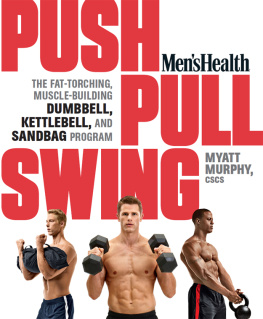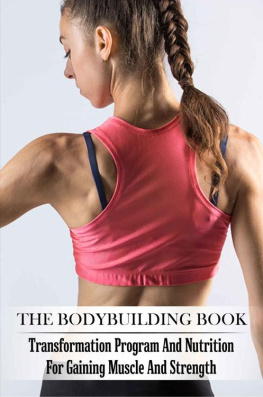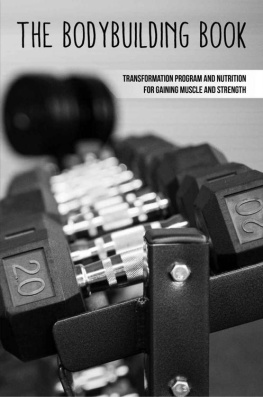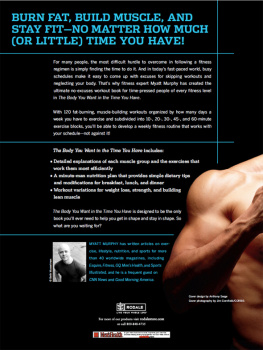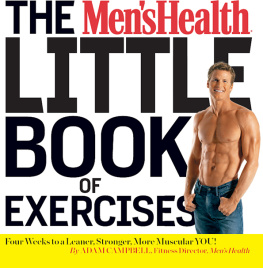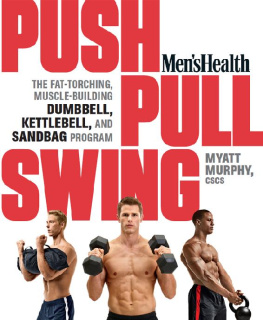This book is intended as a reference volume only, not as a medical manual. The information given here is designed to help you make informed decisions about your health. It is not intended as a substitute for any treatment that may have been prescribed by your doctor. If you suspect that you have a medical problem, we urge you to seek competent medical help.
The information in this book is meant to supplement, not replace, proper exercise training. All forms of exercise pose some inherent risks. The editors and publisher advise readers to take full responsibility for their safety and know their limits. Before practicing the exercises in this book, be sure that your equipment is well-maintained, and do not take risks beyond your level of experience, aptitude, training, and fitness. The exercise and dietary programs in this book are not intended as a substitute for any exercise routine or dietary regimen that may have been prescribed by your doctor. As with all exercise and dietary programs, you should get your doctors approval before beginning.
Mention of specific companies, organizations, or authorities in this book does not imply endorsement by the author or publisher, nor does mention of specific companies, organizations, or authorities imply that they endorse this book, its author, or the publisher.
Internet addresses and telephone numbers given in this book were accurate at the time it went to press.
2014 by Rodale Inc.
Photographs 2014 by Rodale Inc.
All rights reserved. No part of this publication may be reproduced or transmitted in any form or by any means, electronic or mechanical, including photocopying, recording, or any other information storage and retrieval system, without the written permission of the publisher.
Photographs by Mitch Mandel/Rodale Images
Book design by Joanna Williams
Library of Congress Cataloging-in-Publication Data is on file with the publisher.
ISBN 9781623363970
eISBN 9781623363987

We inspire and enable people to improve their lives and the world around them. rodalebooks.com
To K and B.

CONTENTS
The Philosophy of Movement over Muscle
The Holy Trinity of Total-Body Transformation
What You Need to Succeed
The Anatomy of Push, Pull, and Swing
Six Steps for Eating Right While Training for a Leaner, More Muscular Body
Push, Pull, and Swing with the Muscle-Building King
Push, Pull, Swing with This No-Nonsense Work Capacity Tool
Push, Pull, Swing for Real-World Strength
1-Week Tryouts to Learn the Key Moves and Sample Each Piece of Gear
Choose a Blend of Movements for Total-Body Fitness and Optimum Fat Burning
11 Top Trainers Programs for Dumbbells, Kettlebells, and Sandbags
ACKNOWLEDGMENTS
Push, Pull, Swing is the fifth book Ive had the pleasure of writing for Rodale Inc.Mens Health The Body You Want in the Time You Have, The Mens Health Gym Bible, Mens Health Ultimate Dumbbell Guide, and Testosterone Transformation being the other four. This is the second book that has allowed me to work with Editor Jeff Csatari, my colleague from the early days of Mens Health magazine and one of the hardest-working editors I know.
My sincerest thanks go out to every trainer who I consulted during my research, including Tony Ambler-Wright, Lisa Balash, Missy Beaver, Bradley Borne, David Buer, Fabio Comano, Aaron Drogoszewsik, Mike Fantigrassi, Rob Gibson, Joseph Giangrasso, Tony Gonzalez, Steve Hess, Chip Huss, Lorna Kleidman, Annie Malaythong, Ronald Merryman, Erin McGill, Marty Miller, Gabriel Rangel, Prentiss Rhodes, Eric Salvador, Ben Shear, Kyle Stull, Brian Sutton, and David Van Daff. Even though it pained me not to be able to include every one of your workouts due to lack of space, your efforts and interest are greatly appreciated.
A special thanks to the other contributors who made this book possible: Mitch Mandel; Julia Merz; Joanna Williams, art director; Andrew Speer, an owner of Soho Strength Lab who modeled for the exercise photographs in the book; Nikki Weber; Lynn Greenspan; Karen and Courtney Lewis; Troy Schnyder; Stacy Foley; Emily Groff, proofreader (for giving everything her never-miss once-over); Hope Clarke, senior project editor; and the entire Rodale Books publishing team.
Finally, if you learn anything from Push, Pull, Swing, you have my dada hardcore marineto thank. He started me on the path to getting in shape so that one day I might do the same for others. Another one down, Dad.
Myatt Murphy

PART ONE
THE PHILOSOPHY

CHAPTER
PUSH, PULL, SWING
THE PHILOSOPHY OF MOVEMENT OVER MUSCLE
P lease step away from the Smith Machine for a moment and listen to an ancient tale from the Indian subcontinent. Although many different versions of the story exist, the basic gist is this: Several blind men are summoned before the king of a vast land. They are brought into a large room, and inside this room is an elephant. The king asks the blind men to describe the beast, so each man touches a single part of the animals body. One touches the leg and says, It is like a pillar. Another grabs hold of an ear and describes it as a fan. A third strokes its tusk and says its like a plowshare.
Each man was sure he was correct. And he was. But when asked to summarize their findings, they could not agree on how to describe the elephant in its entirety. So stubbornly did they hold to their individual assessments that they argued until they came to blows, to the delight of the king.
The story has many meanings. Most interpret it as a parable to discourage dogma, comparing the blind men to preachers and scholars who are blind to new thinking and hold on to old ways.
In one version of the parable, the Buddha ends the bickering with this verse:
O how they cling and wrangle,
some who claim
For preacher and monk
the honored name!
For, quarreling, each to his view they cling.
Such folk see only one side of a thing.

For strength and athleticism, work the entire elephant.
Youre probably wondering what this has to do with strength training. After all, its rare to find blind men feeling up elephants in a gym. What you do find in gyms, however, is a lot of people who act as stubbornly as those old blind men: They train one way, the same familiar way, perhaps the way they learned 10 years ago from a bodybuilding magazine or a personal trainer. They focus on the vanity muscles, or one style of exercise, or a favorite lift, and as a result they fail to see the bigger picture.

